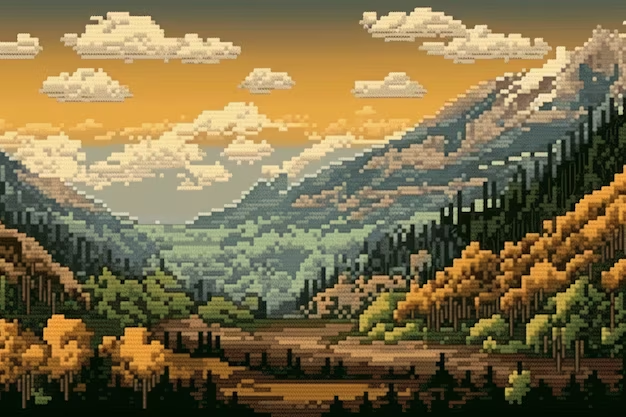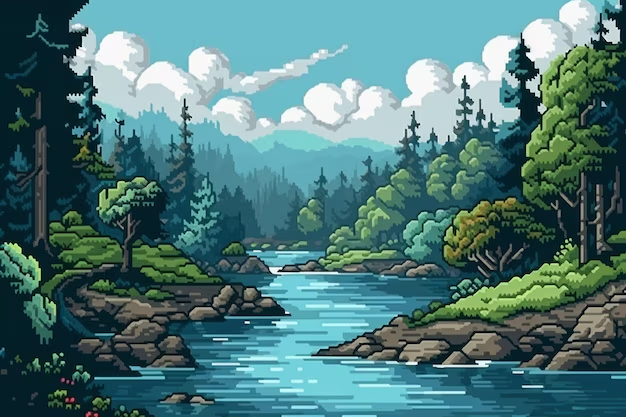Pixel Art in the Age of High Art
Pixel art, images composed of deliberately placed, visible pixels, often conjures retro videogame nostalgia. Yet it is far more than an aesthetic echo of 8‑bit systems. For many contemporary artists, pixel art represents a craft, a site of rigorous constraint, creative ingenuity, and legible form. Paradoxically, the very limitations of pixel grids and strict palettes have become its greatest strength, demanding precision and aesthetic decision-making akin to fine art disciplines like mosaic or pointillism.
While digital art has gained increasing credibility in galleries or colleges, pixel art has often been dismissed as “novelty” or “nostalgia marketing.” However, today pixel-based artworks are finding their way into museum exhibitions, NFT collections commanding six‑figure sums, and academic discussion about visual minimalism. What once seemed like obstacle, tiny resolution, limited color, has proven fertile ground for formal beauty and expressive power.

Historical Context & High‑Art Perception
Digital Skepticism & the Traditional Art World
Digital art faced similar prejudice to that once faced by photography or printmaking. As critics argued: “digital tools simplify the artistic process, it’s less labor-intensive and lacks authenticity.” This bias stems largely from misunderstandings about technique, effort, and reproducibility. Critics often overlook the labor, skill, and iteration required to master software or refine animation frames.
Sean Landes (Art Bog) shares stories of early digital artists, like Anne Spalter and Beeple, who struggled with credibility in traditional fine art circles despite pioneering work in digital media. Even large museums hesitated for years before deeming digital visuals worthy of standard hanging walls, choosing instead planar representations or prints, rarely interactive works.
Pixel Art Enters the Gallery
In 2012, the Smithsonian American Art Museum ran The Art of Video Games exhibition to examine digital graphics’ artistry through retro through to modern games. Yet sprites and UI were not shown as final art, they were background, while concept sketches and renderings were foregrounded.
More recent shows like London’s “Golden Age of Pixel Art” or exhibitions of works by eBoy, whose posters and installations straddle pixel craft and pop culture gallery art, signal growing acceptance. Meanwhile estates have acquired large‑scale pixel-inspired mosaics or projections, citing continuity from pointillism or grid‑based aesthetics.
All this suggests that pixel art is finally being recognized, and interrogated, as more than chill, nostalgic graphics. Its minimalist logic invites high‑art analysis into color theory, reductionism, abstraction, and visual ambiguity.

Tools & Techniques, In-Depth
Resolution, Grid, and Pixel Control
At its foundation, pixel art is the art of controlling each square. As Wikipedia puts it:
“… an image can only be categorized as pixel art when the pixels play an important individual role in the composition … if the pixels are essential to the final aesthetic.”
In practice, that means working at low resolutions, e.g., 16×16, 32×32, or 64×64, and placing each pixel intentionally: no automatic anti-aliasing, no blurry fills.
Palette Work & Color Limitation
A core principle in pixel art: less is more. Most compositions use between 2 and 16 colors, often drawn from hardware palettes such as NES or Game Boy. This limitation forces artists into color theory, using space, hue shifts, and isolation to suggest shading or mood. As one Reddit user writes:
“Color clusters take on a very unique approach … Limited color pallets are best demonstrated … amount of colors is perfectly precise and countable.”
Dithering & Texture
To simulate gradients or intermediate shades, artists often use dithering, alternating pixels of two colors in patterns like checkerboards or stippling to produce a third hue at a distance.
“Imagine you have limited colors … you make a checkerboard … you now … appear to have more.”
Online tutorials note that early consoles required dithering due to low memory, and skilled artists purposely choose it today for texture and depth, even when high-resolution screens no longer blur the effect.
Anti-aliasing & Edge Smoothing
Unlike automatic anti-aliasing in high-resolution apps, pixel artists manually place transitional pixels, often softer colors, along jagged edges to soften diagonal lines without blurring. The challenge lies in subtlety: too much AA, and the piece loses its “pixel purity”; too little, and the edges distract.
Layering, Animation & Onion Skinning
Modern pixel-art editors like Aseprite, Pyxel Edit, or GraphicsGale support:
- Onion-skin frames: view previous/next frames simultaneously
- Layered sprites: separate tiles, effects, characters
- Scripting: automate repetitive tasks
This setup allows efficient frame-by-frame animation, smooth motion cycles, flicker effects, or sprite sheet construction.
Sample Workflow
- Sketch at small scale to plan shapes
- Restrict palette (e.g. 12 colors max)
- Block form, then shade using cluster colors & dither
- Anti-alias edges manually
- Add highlights & textures with minimal strokes
- Animate by adjusting frames, preview with onion-skin
- Scale up (integer multiples) when exporting for screen or print
Such workflows require patience, crafting effective pixel art may take longer than a high-res digital painting. That technical and aesthetic rigor merits comparison to traditional painting techniques.

Case Studies & Commentary: Pixel Artists & Cultural Discourse
Susan Kare: Pioneer of UI Pixel Art
Susan Kare’s 1980s Macintosh icons (the “Chicago” font, paint bucket, lasso, etc.) are early pixel art pioneers. Her work required extreme legibility at tiny sizes. Kare has shaped the way we perceive interface metaphors, and remains celebrated in design circles to this day.
Her icons balance clarity, whimsy, and cultural symbolism, showing how pixel art may reside quietly at the core of our everyday visual world, combining simplicity with deep communicative power.
eBoy: Long-Form Pixel Machine
Founded in 1997 in Berlin, eBoy creates vast isometric landscapes packed with little pixelated figures, objects, and narratives. Their work has been exhibited as posters or installation prints; they describe pixel art as fun, sharp, and inherently abstracting.
Each image may contain thousands of individual pixels, but feels vibrant and lively, like a digital tapestry. eBoy’s career demonstrates that pixel art can scale, both visually and conceptually.
Neo Art & Nostalgia: Medeiros, Neofotistou & Pixel Expression
In Wired’s 2022 retrospective “The Pixel Art Revolution Will Be Televised”, artists Christina‑Antoinette Neofotistou (aka castpixel) and Pedros Medeiros explain that pixel art is not just nostalgia but a creative medium. Neofotistou describes it as “geometric problem‑solving,” driven by the puzzle of spatial constraint on paper‑like grids.
Pixel art now drives independent games like Celeste and Stardew Valley, where emotion, story, and color combine to elevate form beyond mere retro style. Its aesthetic logic is not about limitation, it’s about clarity, suggestiveness, and expressiveness.
“Digital Nostalgia” & NFT Culture
The mainstream visibility of pixel art rose with the meme‑NFT craze: Nyan Cat, a pixel‑animated GIF by Chris Torres, sold for nearly $600,000 in 2021, starkly illustrating that pixel images can command high cultural and monetary value.
Cultural critics observe that many pixel-art NFT buyers describe their aesthetic obsession as nostalgic yet timeless, akin to Cubism or Impressionism allowing space for interpretation.

Perception in the Moment: Bridging Respect and Controversy
High‑Art Credibility Has Evolved
Museums like MoMA and V&A now include videogames, digital installations, and pixel-based exhibitions. Videogames: Design/Play/Disrupt (V&A) showcases games alongside concept art and playable setups, though often still hung on walls as curated objects rather than live works.
Nevertheless, the acceptance of pixel art and digital media in contemporary galleries is no longer a fringe novelty, it’s a recognition that art can emerge from virtual constraints, code, and grids just as well as from paint, marble, or clay.
Criticisms Remain
Old prejudices linger: pixel art is sometimes dismissed as derivative, too tied to 1990s gaming, or lacking “depth” compared to traditional painting. Some still see it as illustration rather than fine art.
However, its inherent reproducibility, once seen as weakness, has become a point of philosophical interest: what is originality when art exists as perfect, immutable code but contains deliberate gestures by an artist?

Why Pixel Art Matters as “True Art”
- Constraint breeds creativity: Just as haiku limits words or sonnets fix meter, pixel art’s limitations yield creative inventiveness via composition, palette, and rhythm.
- Logical visual grammar: Pixels obey geometry; dithering, clustering, and density give rise to texture and nuance. Every mark is calculation.
- Hybrid and recursive: Artists like Susan Kare worked digitally for utility; eBoy and indie devs work pixel for narrative; designers fuse pixel form into installations, textiles, and murals. Its logic intersects craft, graphic design, animation, and fine art.
- Accessible yet rigorous: Pixel art tools like Aseprite or Procreate cost tens of dollars, but mastery takes years. Community tutorials, palette resources like Lospec, and peer feedback demand analytical and aesthetic discipline.
- Cultural counter-nostalgia: The New Yorker observed the rise of “digital nostalgia,” a desire for images from early games as cultural artifacts and memory anchors. Pixel art offers both emotional warmth and formal clarity.
The Legacy of Pixels
Pixel art challenges assumptions, but its rigor, history, and evolving presence across exhibitions and digital collections suggest it is not a “lesser” form, but a deeply conceptual and deliberate one. It asks: can meaning survive minimalism? Can intimacy exist in a grid? As technology advances, VR, high-res 3D, AI-generated imagery, the pixel may remain stubbornly present. Not as relic, but as manifesto: clarity over clutter; constraint over excess; pixel over bevel.
From Kare’s UI icons to eBoy’s urban microcosms, from indie games to NFT memes, pixel art reminds us of the delight in simplicity, the power of structure, and the beauty possible when every mark, every pixel, is intentional. In the same way that a blueprint reveals the essence of architecture, pixel art reveals the essence of the image. And that is art in its purest form.








